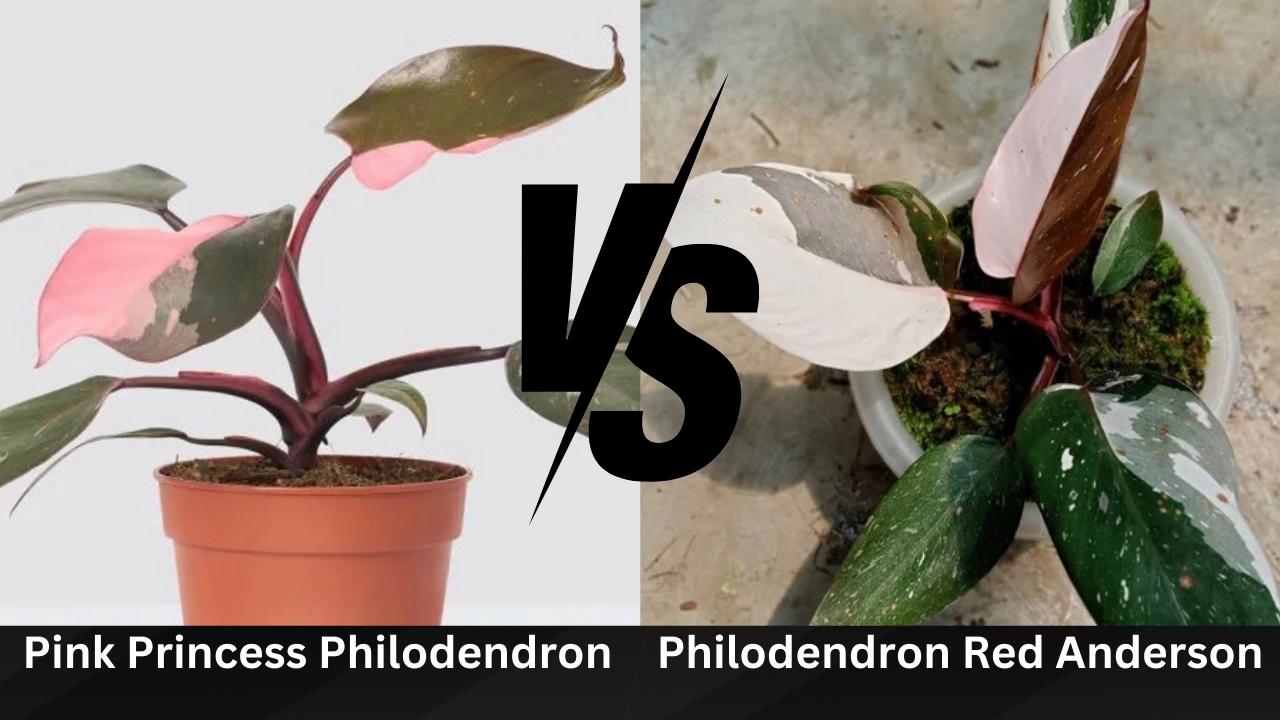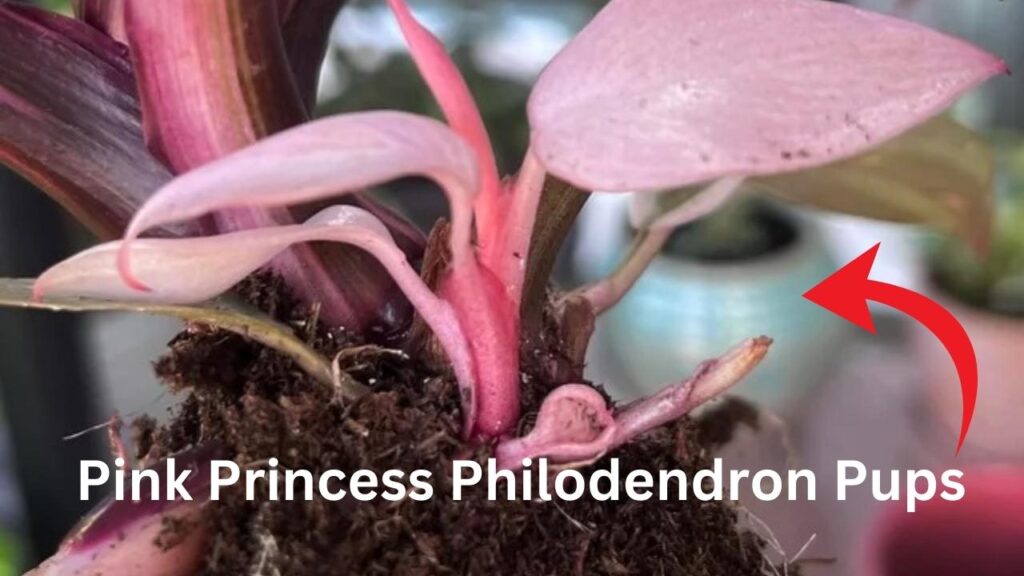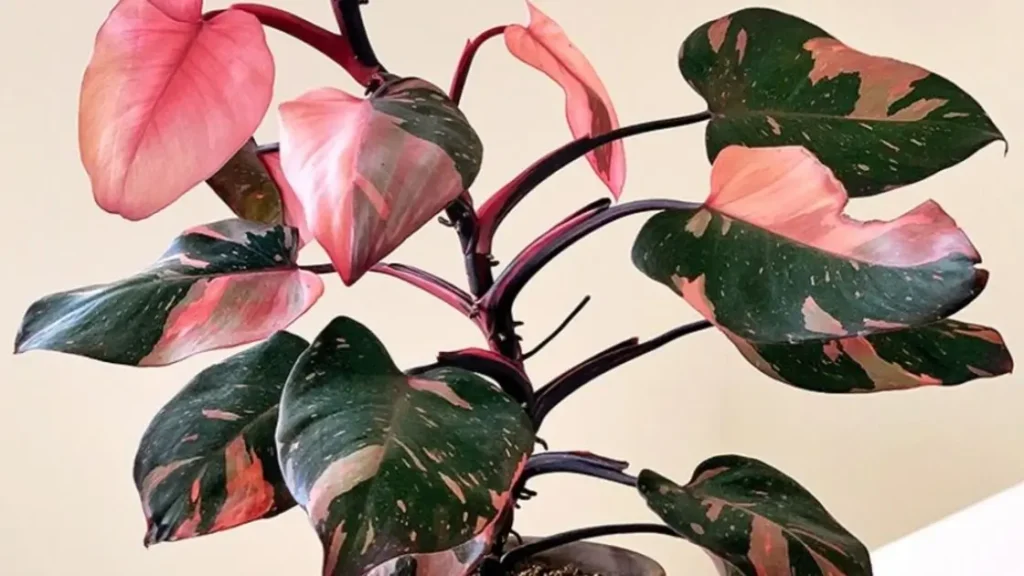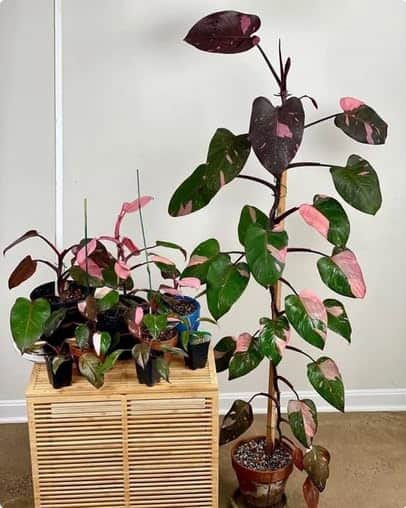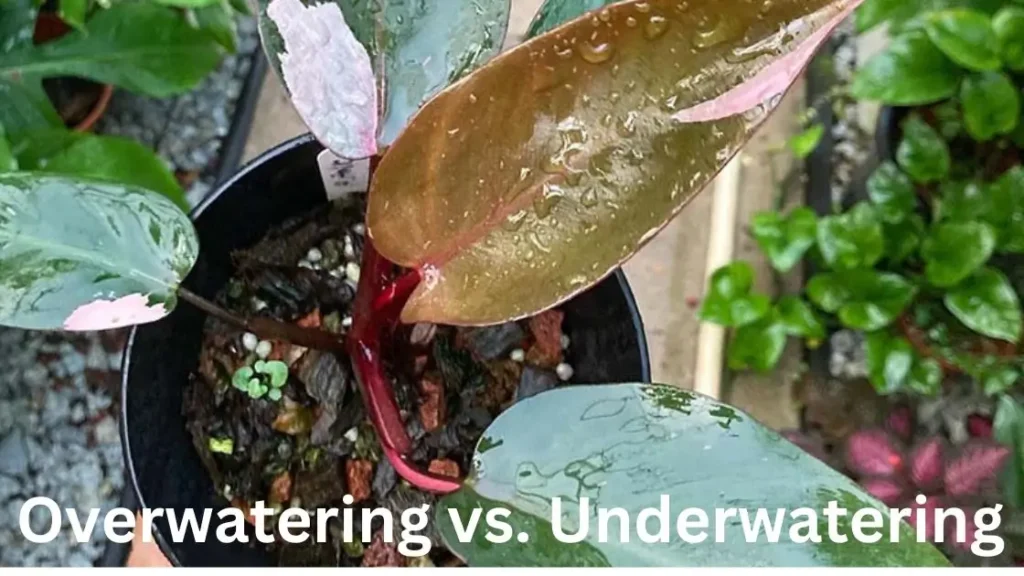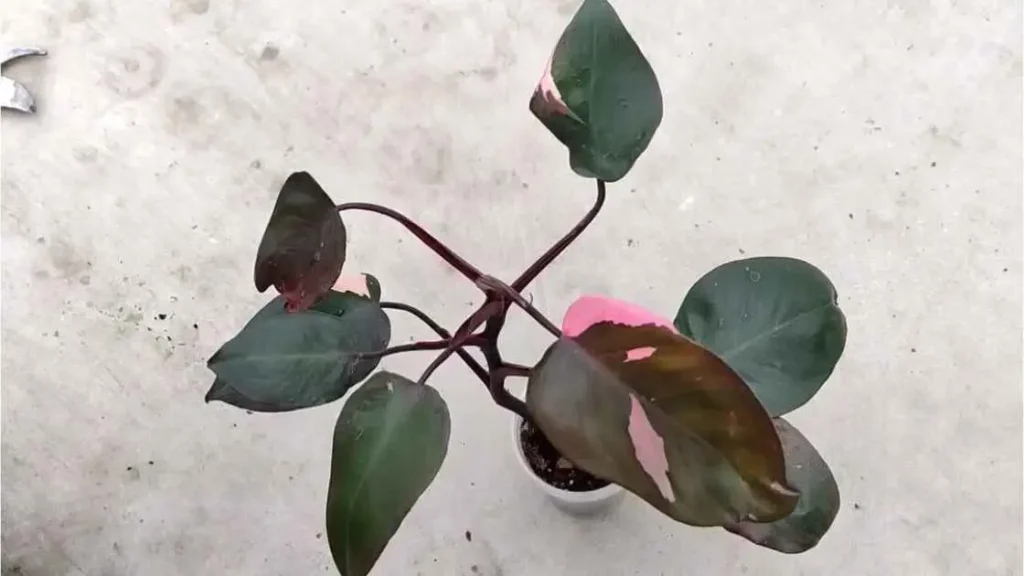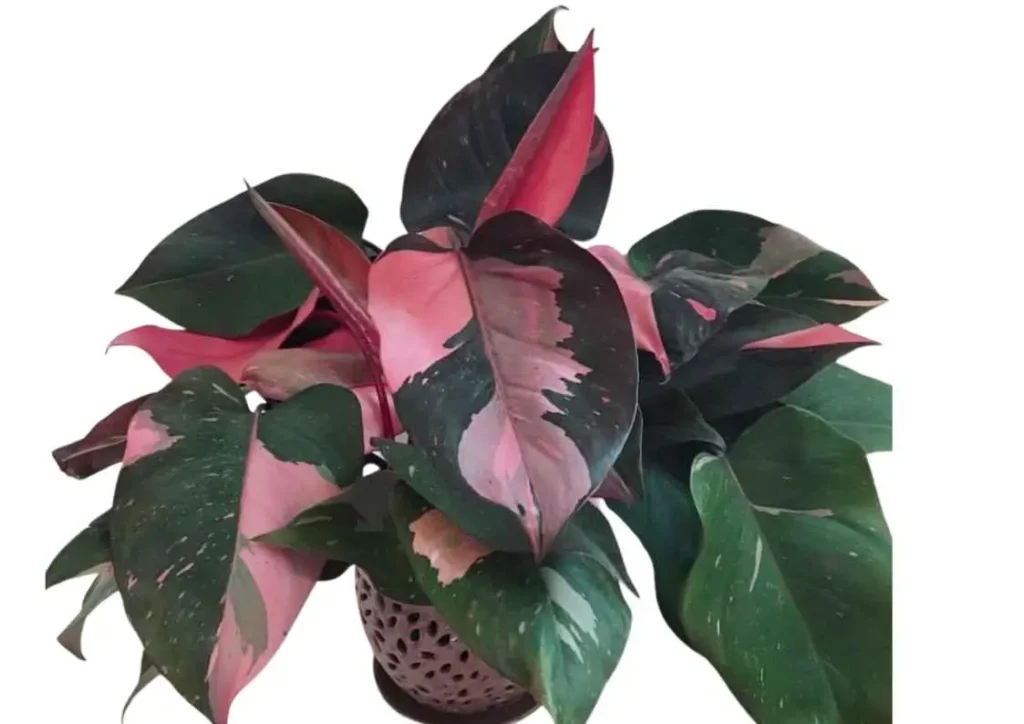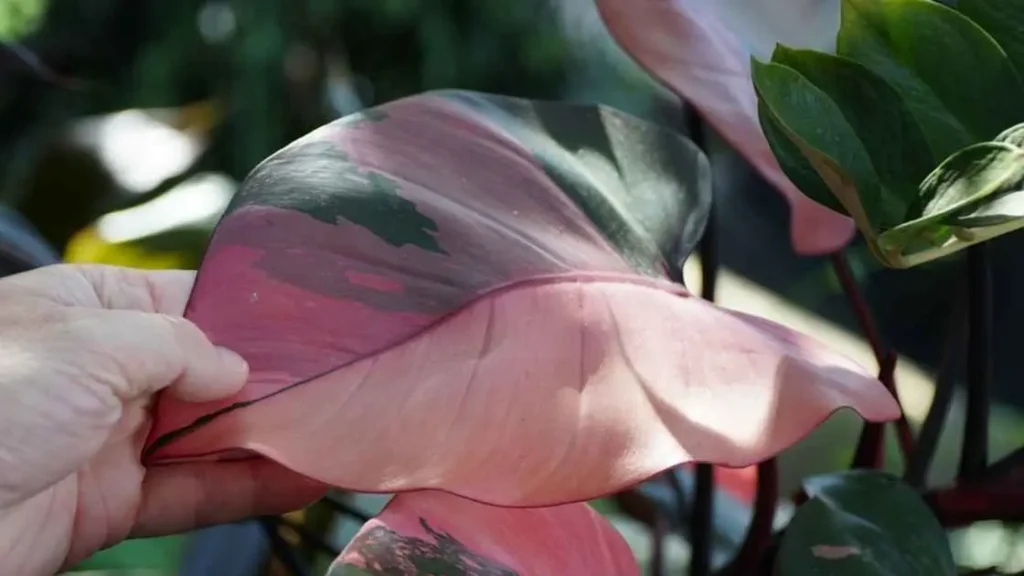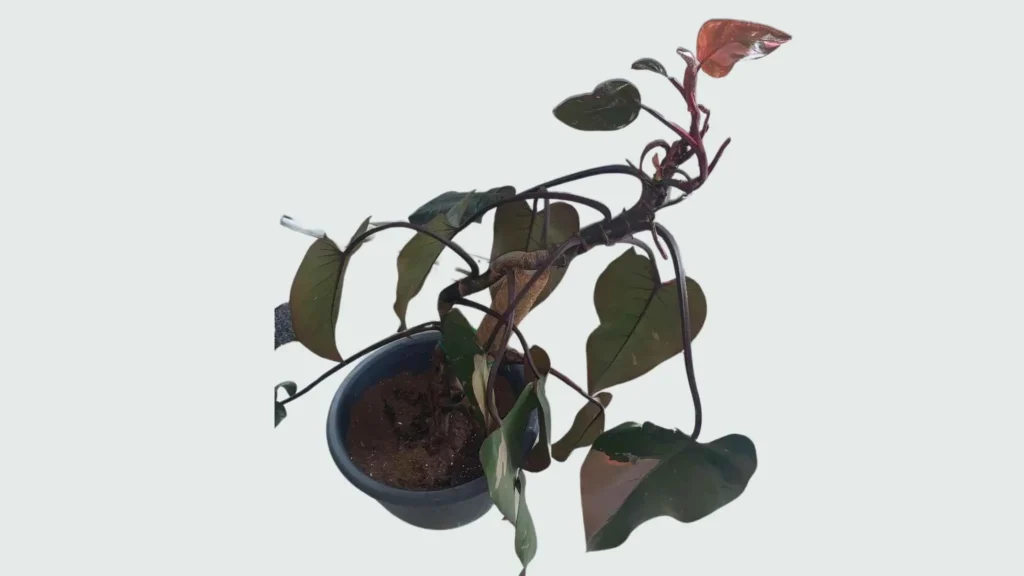Table of Contents
ToggleAre you struggling to choose between the Philodendron Red Anderson vs Pink Princess for your plant collection? With their stunning colors and unique variegation, it’s easy to see why these two are favorites among plant lovers. But which one is the better fit for your home? In this guide, we’ll break down the key differences in appearance, care needs, growth habits, and availability. By the end, you’ll have all the details needed to confidently decide which of these gorgeous Philodendrons deserves a spot in your indoor garden.
Overview of Red Anderson and Pink Princess
Let’s start with a brief look at both plants. This will help us set the stage for a detailed comparison. Understanding the basics of each plant makes it easier to choose the right one for your home.
Philodendron Red Anderson
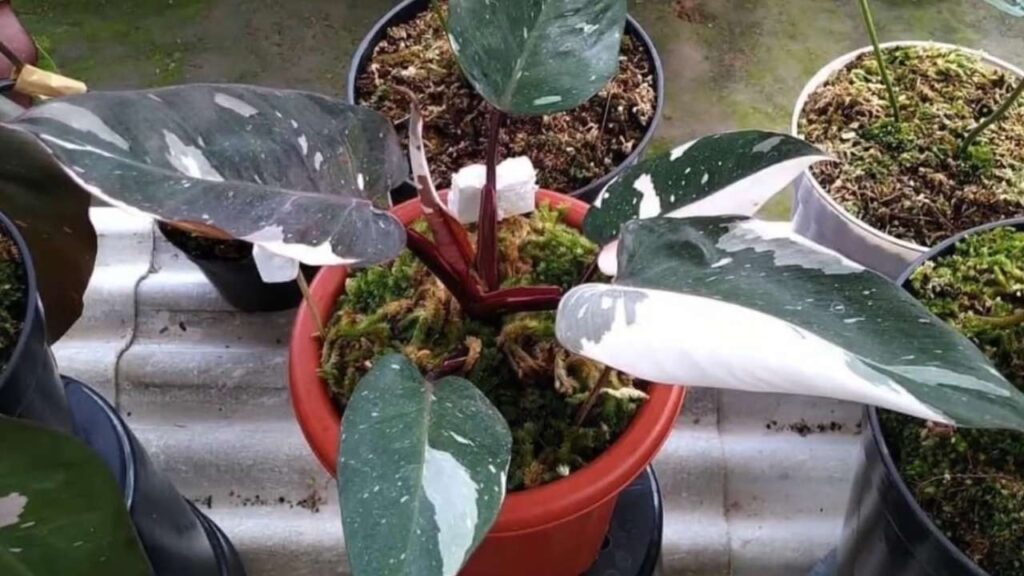
The Philodendron Red Anderson is a rare and unique variety of Philodendron. It is known for its beautiful, variegated leaves. The foliage features a mix of green, cream, and shades of red or pink. This colorful pattern makes it a favorite among collectors. The Red Anderson has a vining growth habit, which means it loves to climb. It’s perfect for adding height to your indoor garden.
The plant is relatively easy to care for, making it a good choice for both beginners and experienced plant owners. It thrives in bright, indirect light and needs well-draining soil to grow well. With the right care, the colors of the leaves can become more vivid, adding a splash of color to any space.
Philodendron Pink Princess
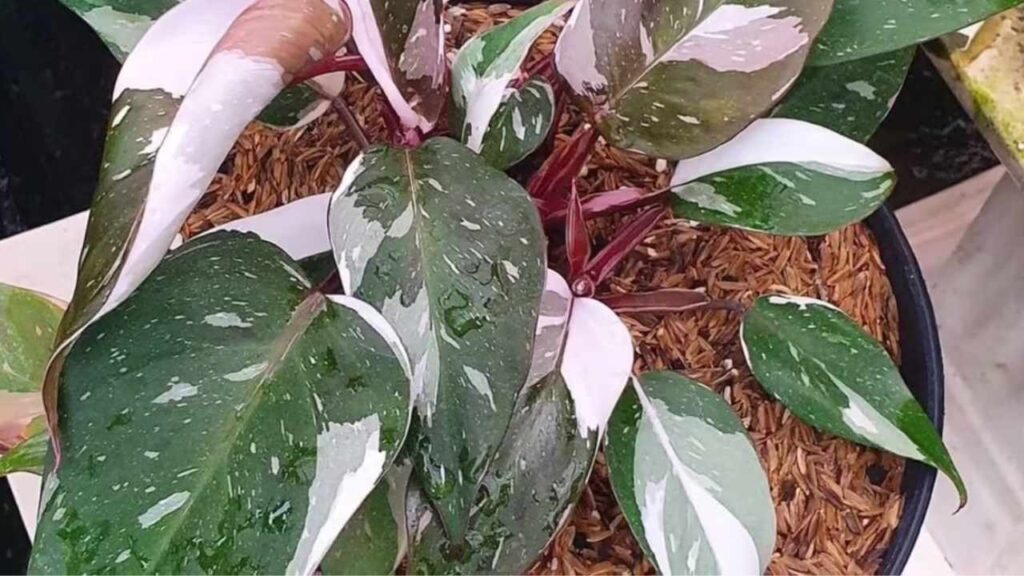
The Philodendron Pink Princess is one of the most popular Philodendron varieties on the market today. It is famous for its striking pink variegation, which appears in patches on its dark green leaves. The contrast between the pink and green makes it a standout in any plant collection. The Pink Princess is also a climbing plant, meaning it loves to grow up trellises or moss poles.
Caring for the Pink Princess can be a bit more challenging compared to the Red Anderson. It needs bright, indirect light to maintain its pink coloring. If the plant doesn’t get enough light, the pink variegation can fade. It also prefers slightly higher humidity, so misting or using a humidifier may help it thrive.
Philodendron Red Anderson vs Pink Princess: Key Differences
Both plants are beautiful, but there are some clear differences. The Red Anderson has a mix of red, pink, and cream variegation, while the Pink Princess has bold, bright pink patches. The Red Anderson is usually easier to care for and less demanding when it comes to humidity. On the other hand, the Pink Princess requires a bit more attention, especially to keep its pink variegation vibrant.
These differences are important if you are trying to decide which plant to add to your collection. In the next section, we’ll dive deeper into the visual appeal of each plant and what makes them special.
Philodendron Red Anderson vs Pink Princess: Appearance and Aesthetic Appeal
When it comes to visual appeal, both the Philodendron Red Anderson and the Pink Princess are showstoppers. However, their looks are quite different. Understanding these differences can help you decide which plant better suits your taste and space.
Leaf Color and Variegation
In the debate of Philodendron Red Anderson vs Pink Princess, the biggest difference is their leaf color. The Red Anderson displays a beautiful mix of green, cream, and shades of red or light pink. The colors are often subtle, creating a soft, elegant look. Its variegation appears in streaks or patches, giving each leaf a unique pattern.
On the other hand, the Pink Princess is known for its bold and striking appearance. It features dark green leaves with bright pink patches that stand out sharply. The pink variegation can cover large sections of the leaf, making it a true eye-catcher. The contrast between the pink and green is dramatic, giving the Pink Princess a unique and modern look.
Leaf Shape and Size
The shape of the leaves is another point of difference. The Philodendron Red Anderson typically has elongated, heart-shaped leaves. They are medium-sized, which gives the plant a delicate appearance. The leaves are smooth and have a slight glossy finish, adding a touch of elegance.
In contrast, the Pink Princess has broader, heart-shaped leaves. They are slightly larger and thicker compared to the Red Anderson. The texture of the leaves is smooth but can feel slightly leathery to the touch. The large, vibrant leaves make the Pink Princess a bold statement piece in any room.
In the comparison of Philodendron Red Anderson vs Pink Princess, it often comes down to personal taste. Do you prefer the soft, delicate variegation of the Red Anderson, or the bold, vibrant pink of the Pink Princess? Your choice may depend on the overall look you want to achieve in your home.
Care Requirements: Which Plant is Easier to Maintain?
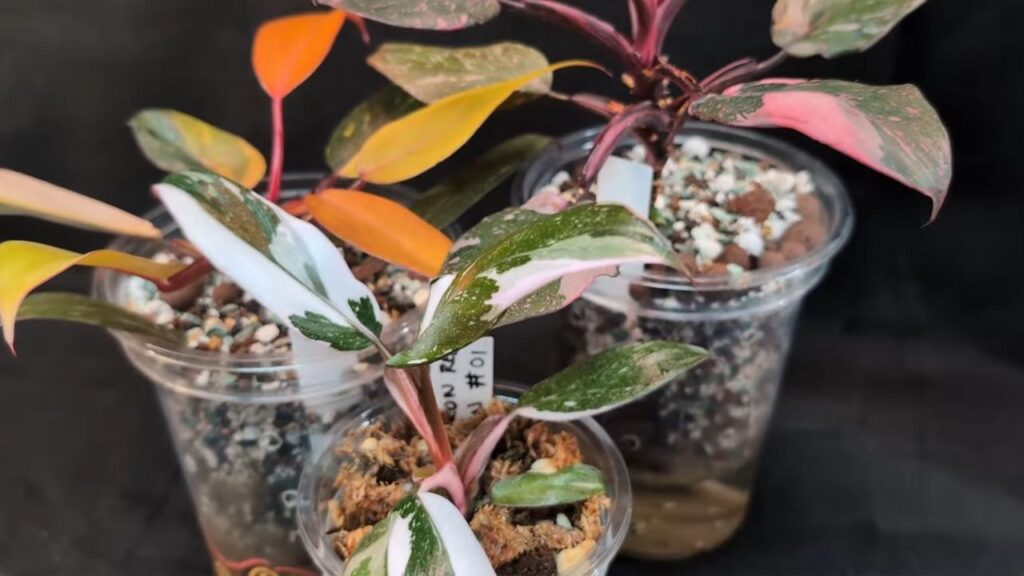
Caring for your Philodendron properly is key to keeping it healthy and beautiful. When it comes to Philodendron Red Anderson vs Pink Princess, both have unique needs. Knowing these requirements will help you choose the plant that best fits your lifestyle.
Light Needs
Both the Philodendron Red Anderson and the Pink Princess prefer bright, indirect light. However, there are some differences. The Red Anderson is a bit more adaptable and can tolerate lower light conditions. It will still grow well in a spot with filtered sunlight.
On the other hand, the Pink Princess needs more light to maintain its vibrant pink color. If the Pink Princess does not get enough light, the pink patches may fade, and the leaves may turn mostly green. A spot near a bright window with indirect sunlight is ideal for this plant. Direct sunlight can scorch the leaves, so be sure to provide filtered light.
Watering Needs
In the battle of Philodendron Red Anderson vs Pink Princess, their watering needs are quite similar. Both plants prefer their soil to be slightly moist but not soggy. The Red Anderson can handle a bit more dryness between waterings, making it slightly easier for those who might forget to water regularly.
The Pink Princess, however, is more sensitive to drying out. It needs a consistent watering schedule. Let the top inch of the soil dry out before watering again. Overwatering can lead to root rot, so be careful not to keep the soil too wet.
Humidity and Temperature
Both plants love humidity. In the comparison of Philodendron Red Anderson vs Pink Princess, the Pink Princess tends to need higher humidity levels to thrive. It prefers a humidity level of at least 60%, especially if you want the best pink variegation. Using a humidifier or misting the plant regularly can help maintain the right conditions.
The Red Anderson is a bit more forgiving. It can still do well in average indoor humidity, around 40-50%. However, both plants will benefit from increased humidity, especially in dry seasons.
Soil and Fertilizer Needs
For soil, both the Philodendron Red Anderson and the Pink Princess prefer well-draining, airy soil. A mix of peat, perlite, and orchid bark works well. This type of soil allows the roots to breathe and prevents water from sitting in the pot.
Fertilizing is also important for both plants. Use a balanced liquid fertilizer every 4-6 weeks during the growing season (spring and summer). Avoid fertilizing during the winter when the plant’s growth slows down.
Pruning and Maintenance
Pruning helps both plants look their best. The Red Anderson might need light pruning to remove old or damaged leaves. It’s a fast grower and can become leggy if not trimmed regularly.
The Pink Princess often needs more pruning, especially to maintain its variegation. Sometimes, the plant may produce all-green leaves, which can reduce the pink patches. Pruning these green leaves can help the plant focus on producing more variegated growth.
In the end, when considering Philodendron Red Anderson vs Pink Princess, the Red Anderson is slightly easier to care for. It’s more forgiving with light and humidity. The Pink Princess, while stunning, requires a bit more attention, especially to keep its pink coloring vibrant.
Philodendron Red Anderson vs Pink Princess: Growth Rate and Pattern
Understanding the growth habits of your plant can help you care for it better. In the comparison of Philodendron Red Anderson vs Pink Princess, both are vining plants, but there are some differences in their growth style and speed.
Growth Rate and Pattern
The Philodendron Red Anderson has a moderate growth rate. It tends to grow quickly if given the right conditions, such as bright, indirect light and regular feeding. The Red Anderson is a vining plant, which means it loves to climb. Using a moss pole or trellis can help it grow upward and show off its beautiful variegated leaves.
The Pink Princess, on the other hand, is a bit slower to grow. It also climbs, but it may take longer to reach the same height as the Red Anderson. The growth rate of the Pink Princess can be affected by its variegation. Leaves with more pink tend to grow slower since they have less green tissue to produce energy. This makes the Pink Princess a bit more delicate when it comes to growth.
Propagation Techniques
Propagating these Philodendrons is a great way to expand your collection or share plants with friends. For both the Philodendron Red Anderson and the Pink Princess, the best way to propagate is through stem cuttings.
Here’s How to Propagate:
- Choose a Healthy Stem: Look for a stem with at least one node (the bump where roots can grow) and a few healthy leaves.
- Make a Clean Cut: Use a sharp, clean knife or scissors to cut the stem below the node.
- Prepare the Cutting: Remove the leaves near the bottom of the cutting. This helps focus the plant’s energy on root growth.
- Place in Water or Soil: You can place the cutting in water or directly into moist soil. If using water, change it every few days to keep it fresh.
- Wait for Roots to Grow: Roots usually start to appear in 2-4 weeks. Once the roots are a few inches long, you can transplant the cutting into soil.
Propagation Challenges
In the case of Philodendron Red Anderson vs Pink Princess, both plants can be propagated in similar ways, but the Pink Princess may be trickier. Due to its variegation, some cuttings might produce leaves with little to no pink. This can happen because the plant’s genetics are unstable. It’s important to take cuttings from stems with good variegation to increase the chances of new pink growth.
The Red Anderson is generally easier to propagate. It has more consistent variegation, and its cuttings root quickly if given the right conditions. It’s a good choice for beginners who want to try their hand at plant propagation.
In conclusion, if you’re looking for a plant that grows quickly and is easy to propagate, the Red Anderson might be the better choice. The Pink Princess requires more patience but can be very rewarding with its stunning pink leaves.
Cost and Availability: Which is More Accessible?
When choosing a plant, cost and availability are important factors. In the debate of Philodendron Red Anderson vs Pink Princess, these two aspects can be quite different. Let’s look at what you can expect when shopping for these stunning plants.
Cost Comparison
The Philodendron Pink Princess is usually more expensive than the Red Anderson. This is because the Pink Princess is very popular among collectors, and its bright pink variegation makes it a sought-after plant. Prices for a healthy Pink Princess can start around $50 for small plants and can go up to several hundred dollars for larger, well-varginated specimens. The more pink there is on the leaves, the higher the price.
The Philodendron Red Anderson tends to be less expensive. It is still considered a rare plant, but it’s not as hyped in the market as the Pink Princess. Prices for a small Red Anderson typically start around $30, and larger plants can cost up to $100 or more, depending on the level of variegation and size.
Availability in the Market
When it comes to availability, the Philodendron Red Anderson vs Pink Princess comparison is quite interesting. The Pink Princess can be harder to find due to its popularity. Many plant enthusiasts want to add it to their collection, so it often sells out quickly at nurseries and online stores. If you find a well-variegated Pink Princess, it’s best to buy it quickly, as it may not stay in stock for long.
The Red Anderson, while still rare, is usually easier to find. It is less commonly requested by collectors, so you might have better luck finding one in stock. You can often find the Red Anderson at specialized plant shops, online plant stores, or even local nurseries that carry rare houseplants.
Tips for Buying Safely
If you’re planning to buy either of these plants online, make sure to purchase from a trusted seller. In the case of Philodendron Red Anderson vs Pink Princess, many fake or mislabeled plants are sold due to high demand. Always ask for clear photos of the plant you are buying and check the reviews of the seller. Look for healthy leaves, good variegation, and no signs of pests before making a purchase.
Is It Worth the Investment?
The choice between the Philodendron Red Anderson vs Pink Princess often comes down to budget and personal preference. If you’re looking for a more affordable, easier-to-find option, the Red Anderson might be the better choice. However, if you’re willing to spend a bit more for a plant with striking pink variegation, the Pink Princess is a fantastic statement piece for any collection.
Philodendron Red Anderson vs Pink Princess Pros and Cons of Each Plant
Choosing between the Philodendron Red Anderson vs Pink Princess can be tricky. Both are stunning, but each comes with its own set of benefits and drawbacks. Let’s break down the pros and cons of each plant to help you make the best choice.
Philodendron Red Anderson: Pros and Cons
Pros:
- Unique Variegation: The Red Anderson features a mix of red, cream, and green shades. The colors are softer and blend well, giving the plant a refined look.
- Easier to Care For: This plant is more forgiving when it comes to light and humidity. It adapts well to typical indoor conditions, making it a good option for beginners.
- Faster Growth: The Red Anderson tends to grow quicker and can climb easily if given a moss pole or support.
- More Affordable: It is usually less expensive than the Pink Princess, making it a great choice for those on a budget.
Cons:
- Less Bold Color: While the variegation is beautiful, it is not as striking as the bright pink seen in the Pink Princess. It may not stand out as much in a large plant collection.
- Limited Availability: Although easier to find than the Pink Princess, the Red Anderson is still considered a rare plant and may not always be in stock.
Philodendron Pink Princess: Pros and Cons
Pros:
- Stunning Pink Variegation: The main appeal of the Pink Princess is its bright, bold pink patches. The color contrast makes it a real showstopper.
- High Demand: This plant is highly sought after by collectors. Owning a Pink Princess can be a point of pride for many plant enthusiasts.
- Good Climber: Like the Red Anderson, the Pink Princess is a vining plant. It grows well on trellises or moss poles, adding height and visual interest to your space.
Cons:
- Higher Care Needs: The Pink Princess can be more challenging to care for. It needs bright, indirect light and high humidity to keep its pink variegation vibrant.
- Slower Growth: Due to its heavy variegation, the Pink Princess often grows slower than the Red Anderson. It may take longer to mature and fill out.
- Expensive: The Pink Princess is usually pricier due to its popularity and demand. It may not be the best choice if you’re looking for a budget-friendly plant.
Final Thoughts on Philodendron Red Anderson vs Pink Princess
Both plants have their own appeal. The Red Anderson is a great option if you want a unique, easier-to-care-for plant that grows quickly. The Pink Princess, on the other hand, offers striking visual impact with its bright pink leaves but requires a bit more attention and investment.
Philodendron Red Anderson vs Pink Princess: Which Philodendron is Right for You?
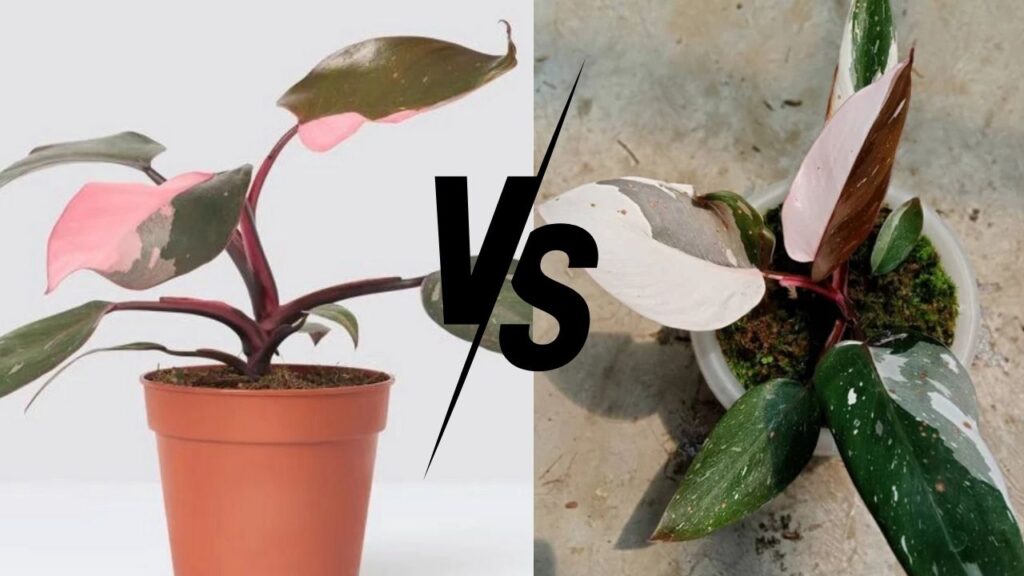
Choosing between the Philodendron Red Anderson vs Pink Princess can be tough. Both are beautiful plants, but the best choice depends on your preferences and lifestyle. Let’s go over some factors that can help you decide.
Consider Your Aesthetic Preference
If you love bold and vibrant colors, the Pink Princess might be the better fit. Its bright pink variegation is eye-catching and makes a strong statement in any plant collection. It’s perfect if you want a plant that stands out and grabs attention.
On the other hand, if you prefer a softer, more subtle look, the Red Anderson may be a better choice. The mix of red, cream, and green gives it an elegant appearance. It blends well with other plants and can add a touch of color without being too bold.
Think About Care Requirements
When it comes to Philodendron Red Anderson vs Pink Princess, the care needs are slightly different. If you are new to houseplants or don’t have a lot of time for maintenance, the Red Anderson is the easier option. It adapts well to average indoor conditions and can handle a bit of neglect.
The Pink Princess, while stunning, needs more care. It thrives in bright, indirect light and prefers high humidity. If you are willing to put in the extra effort and enjoy a challenge, the Pink Princess can be very rewarding. However, it may not be the best choice for beginners.
Budget and Availability
Budget is another key factor in the Philodendron Red Anderson vs Pink Princess decision. The Red Anderson is generally more affordable and easier to find. It’s a great choice if you want a rare plant without spending a lot of money.
The Pink Princess is more expensive due to its popularity and demand. If you are looking for a plant that’s highly valued by collectors and don’t mind the higher price, the Pink Princess is a fantastic investment. Just be prepared to hunt for a good specimen, as it often sells out quickly.
Your Experience Level
For beginners, the Red Anderson is a better starting point. It’s less demanding and easier to care for. If you’re an experienced indoor gardener or plant collector looking for a challenge, the Pink Princess may be more exciting. It requires more precise care but can be very rewarding when it thrives.
Space and Display Options
Both plants are vining types and look great on a moss pole or trellis. However, the Pink Princess tends to stay a bit more compact, making it a good fit for smaller spaces. The Red Anderson grows faster and can take up more room, so it’s better for those who have plenty of space to let it climb and spread out.
Final Recommendation
In the end, the choice between Philodendron Red Anderson vs Pink Princess comes down to what you value most. If you want a unique, easy-care plant with lovely soft colors, go for the Red Anderson. If you crave a striking plant with bold pink variegation and are ready for the extra care it needs, the Pink Princess is the way to go.
Conclusion
Choosing between the Philodendron Red Anderson vs Pink Princess is a personal decision that depends on your preferences, experience, and the care you can provide. Both plants are beautiful additions to any indoor garden, but they cater to slightly different needs and tastes.
If you are looking for a plant that is easier to care for, with a softer look and reliable growth, the Philodendron Red Anderson is a great choice. It adapts well to most indoor environments and is generally more forgiving, making it a wonderful option for beginners or anyone who wants a low-maintenance plant.
On the other hand, the Pink Princess offers a bold and striking appearance with its vibrant pink variegation. It’s perfect for those who want a statement piece and are willing to give it the extra attention it needs. While it may be more demanding, the rewards of seeing those bright pink leaves make it worth the effort, especially for experienced plant enthusiasts.
In the end, the decision comes down to what you are looking for in a plant. Do you prefer the unique mix of red and cream tones in the Red Anderson, or are you drawn to the bold pink patches of the Pink Princess? Whichever you choose, both plants will bring beauty and a touch of nature into your home.
I hope this guide has helped you understand the differences between the Philodendron Red Anderson vs Pink Princess and made it easier to decide which one is right for your collection. If you have any questions or want to share your experience with these plants, feel free to leave a comment. Happy growing and good luck with your new Philodendron!
Frequently Asked Questions (FAQs)
Can I grow both the Philodendron Red Anderson and Pink Princess together?
Yes, you can grow both plants together. They have similar care needs, such as bright, indirect light and well-draining soil. Just ensure each plant has enough space to grow.
How can I enhance the pink color in my Pink Princess Philodendron?
To boost the pink color, place your plant in bright, indirect light. Avoid direct sunlight, as it can damage the leaves. Consistent care and proper lighting help maintain vibrant pink hues.
Are these plants safe for pets?
No, both the Philodendron Red Anderson and Pink Princess are toxic to pets if ingested. Keep them out of reach of cats, dogs, and other animals to prevent any health issues.
How often should I water these Philodendrons?
Water when the top inch of soil feels dry. Overwatering can lead to root rot, so it’s better to let the soil dry slightly between waterings. Adjust watering frequency based on your home’s humidity and temperature.
Can I propagate these plants at home?
Yes, both plants can be propagated through stem cuttings. Cut a healthy stem with at least one node, place it in water or moist soil, and wait for roots to develop before planting. This is a great way to grow new plants from your existing ones.
Related
Discover more from Pink Philodendron
Subscribe to get the latest posts sent to your email.

